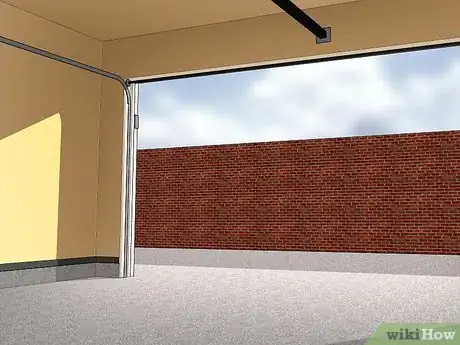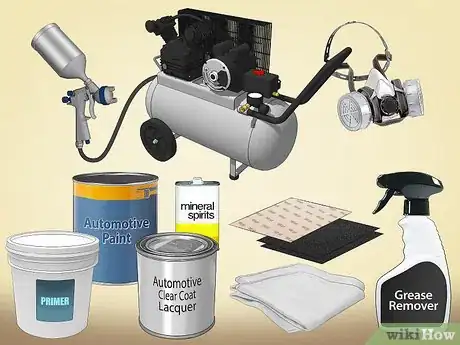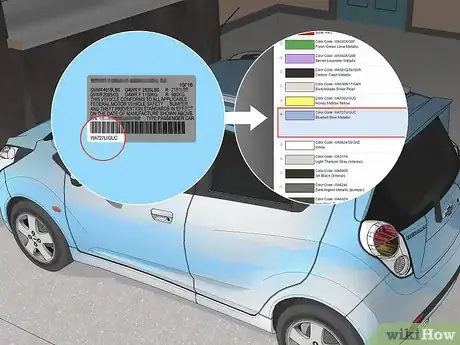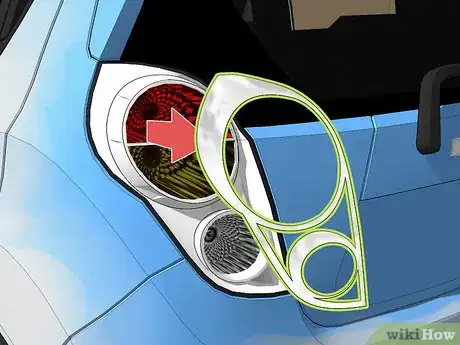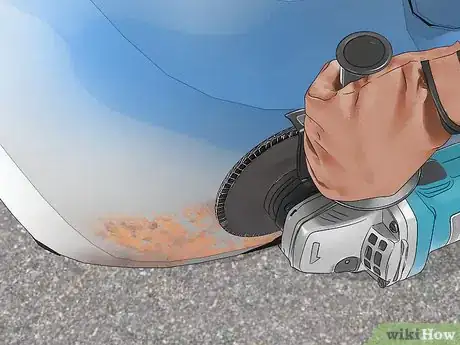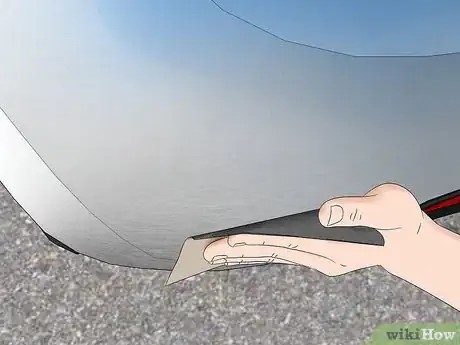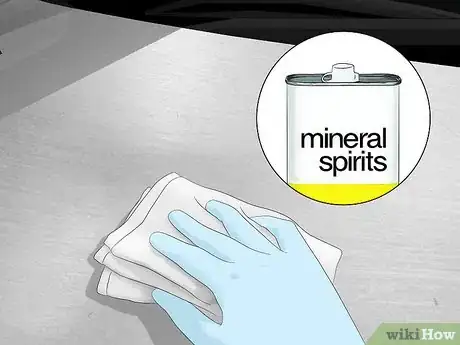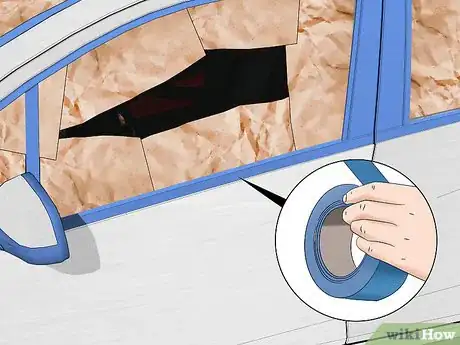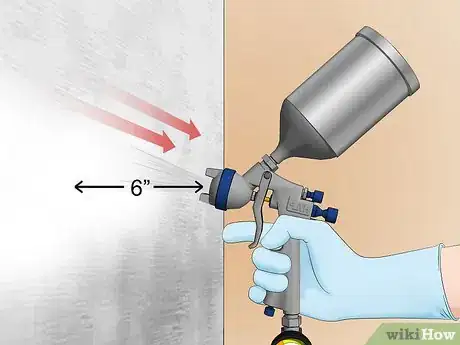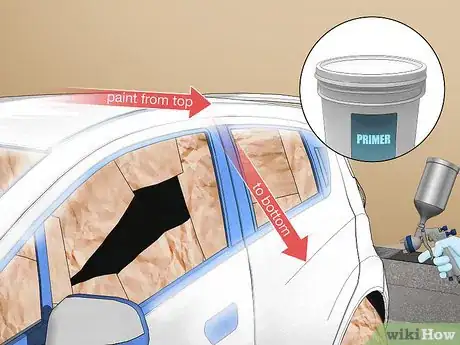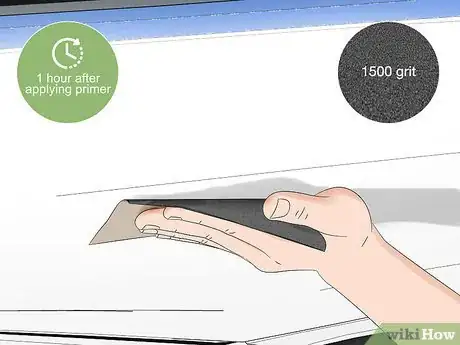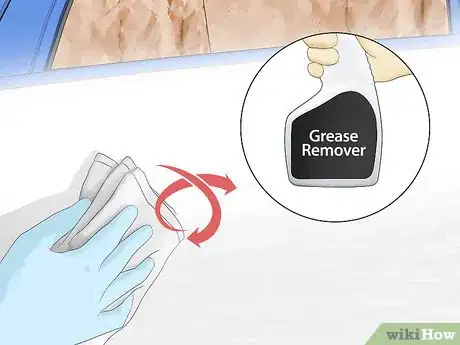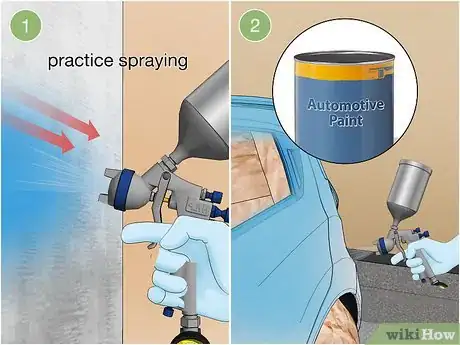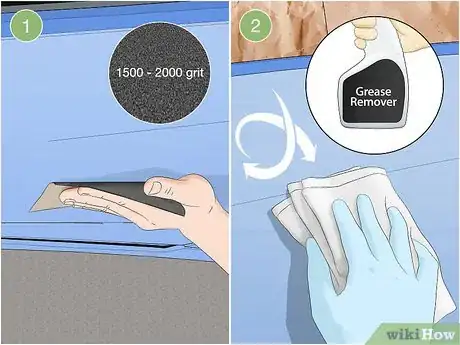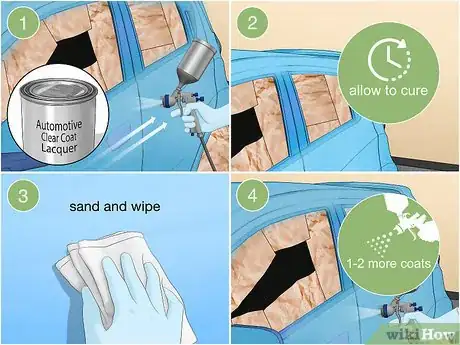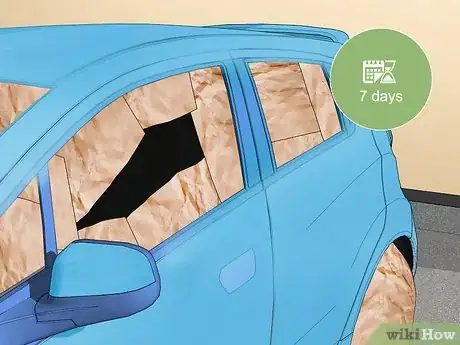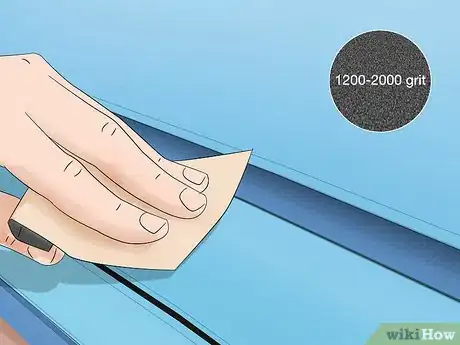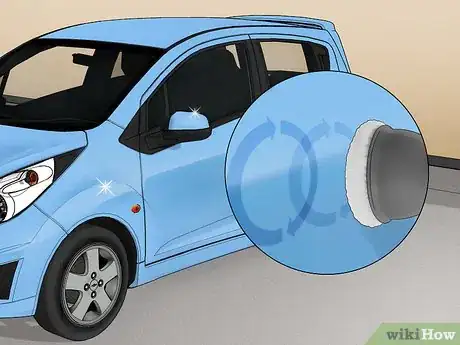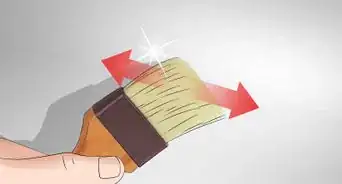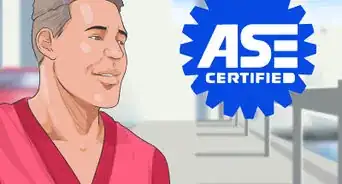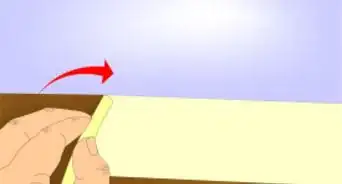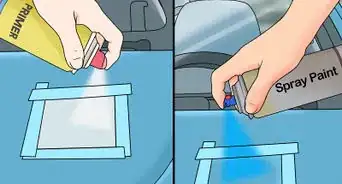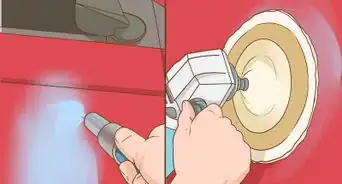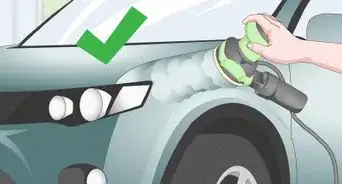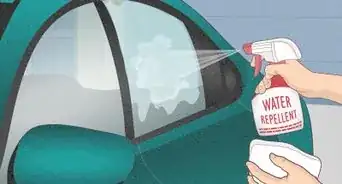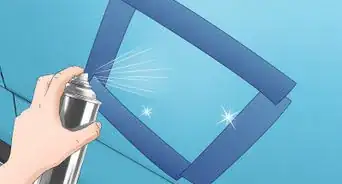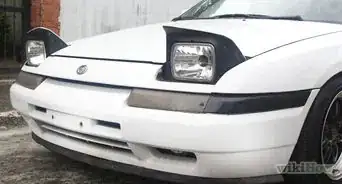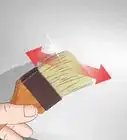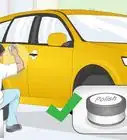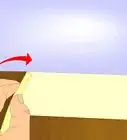This article was co-authored by Angel Ricardo and by wikiHow staff writer, Christopher M. Osborne, PhD. Angel Ricardo is the owner of Ricardo's Mobile Auto Detail headquartered in Venice, California. With over 10 years of experience in mobile detailing, Angel continues to attend auto detailing trainings to improve his customer service and auto detailing skills.
There are 8 references cited in this article, which can be found at the bottom of the page.
wikiHow marks an article as reader-approved once it receives enough positive feedback. This article received 16 testimonials and 100% of readers who voted found it helpful, earning it our reader-approved status.
This article has been viewed 1,809,619 times.
Having your car repainted professionally can be a pricey proposition. However, it’s possible to save some money and have a bit of fun by doing the job yourself! In reality, though, painting a car properly requires a solid technique and a good bit of practice. Use the following overview for guidance, but watch an experienced painter in action and practice on a “junker” or two before trying to paint your own car.
Steps
Setting up for the Job
-
1Find a covered, ventilated, low-dust, safe place to do the job. To safely and skillfully paint a car, you’ll need an enclosed workspace with excellent ventilation, minimal dust, good lighting, and lots of room to work around the vehicle. Your home garage may fit the bill, but do not paint in your garage if it contains a water heater, furnace, or other source of potential ignition for the paint fumes that will accumulate during the process.
- It may be illegal where you live to paint a vehicle in your garage. Check with the local authorities before proceeding.
- Covering the interior of your workspace with plastic sheeting can limit overspray and reduce the amount of dust that may fall on your new paint job while it cures.
-
2Take safety seriously when gathering your supplies. When you head to the home center, paint shop, and/or auto parts store to pick up the sprayer, primer, paint, sanding tools, and other necessary materials for the job, make sure not to neglect health and safety equipment. First and foremost, buy a respirator mask and make sure you know how to use it properly.[1]
- Choose a respirator that is designed and marketed for use in vehicle painting.
- Additionally, wear safety goggles, nitrile gloves, and disposable plastic coveralls with a hood whenever you’re removing the old paint or adding the new stuff.
Advertisement -
3Match the existing paint color, if desired, by using your vehicle’s color code. You’ll typically find the color code on the “compliance plate” located under the hood—it also contains the VIN number and other essential vehicle info. The color code may also be noted on the inside of the driver’s side door frame, near where you’ll find info on things like the ideal tire pressure for your vehicle.[2]
- Take the color code to any retailer that supplies automotive paint to get the right match.
- If you can’t find the code, contact the vehicle manufacturer so you can get the correct code.
- Alternatively, some automotive supply shops may be able to color match the paint without the code.
- It can be really hard to match the color of a paint job if you don’t get the exact type of paint that was used before. You can hide a small scratch or something with a similar color, but your eyes will still be able to spot the difference.[3]
Sanding, Cleaning, and Masking the Car
-
1Remove any chrome or plastic trim that can be taken off easily. Many of the body panel moldings used on cars can be “snapped” off and snapped back on easily, but if a gentle attempt to remove it is not successful, do not try to force it off. Auto supply stores often sell tools that aid in the process of removing trim.
- Refer to your vehicle manual for info on properly removing trim pieces.
- Any trim pieces that refuse to come off can be taped over instead.
-
2Repair any rust spots before sanding down the entire car. Because you’ll be sanding and repainting the whole car, you don’t need to be too gentle here. Put on your respirator, overalls, gloves, and safety goggles, and use a metal grinder to grind away all of the rust. If you end up with any small holes, use a putty knife to apply a non-rusting auto body filler, then smooth out the patch material when you move on to sanding.[4]
- If you paint over rust, it’s just going to spread over time.[5]
- For larger rust holes, you’ll have to get more creative. Some auto enthusiasts create patches out of cut pieces of beer or soda cans, or thin sheets of semi-rigid plastic. These are adhered in place with auto body filler, then slowly sanded down smooth.
-
3Sand the paint down to bare metal whenever possible. You can, if necessary, only sand down to the primer layer, or even just sand down the finished coats enough for the new paint to stick. However, you’ll always get a better finished look if you take the time to sand the entire car down to the bare metal. Use a dual-action (DA) power sander with a 400 or 600-grit pad and work in circular motions with constant movement.[6]
- A 600-grit pad will take longer to do the job, but will also reduce the chances of scratching and etching the surface more than desired.
- Your aim is for a matte finish on the bare metal, not to polish it smooth.
- Always wear your safety equipment, most especially eye protection and your respirator, when sanding.
-
4Clean all vehicle surfaces thoroughly once you’re done sanding. Use tack cloths to remove visible surface dust, then wipe every surface of the vehicle with rags dampened with paint thinner, mineral spirits, or denatured alcohol. This wipedown will remove any remaining dust and clean away any oils from the surface.[7]
- Don’t mix surface cleaning materials. If you start out using paint thinner, clean the entire car with rags dampened only with paint thinner.
- Give the vehicle surfaces 5-10 minutes to dry before taping off the areas you don’t want to paint.
-
5Cover all areas you don’t want to paint with painter’s tape and masking paper or plastic. For instance, you’ll need to mask off the window glass, window trim, and mirrors, and may also need to cover things like the door handles and grills. Make sure to smooth the painter’s tape over the edges of the covered areas completely; otherwise, the paint will sneak through any gaps.<
- If you haven’t already done so, cover your workspace with plastic if you want to avoid painting it too!
Priming the Vehicle
-
1Practice your spraying technique on a scrap car door or sheet metal. Set up your compressed air auto paint sprayer and add your chosen corrosion-resistant, self-etching automotive primer, all according to the product instructions. Hold the sprayer about 6 in (15 cm) from your practice surface, squeeze the trigger, and use a steady, side-to-side motion to coat the surface. Always maintain this sweeping motion while spraying.[8]
- A scrap car door from a local junkyard is the best practice material. However, a sheet of scrap steel will also do the job. A sheet of scrap wood or even cardboard is OK if necessary, but the primer and paint won’t spread and adhere in the same fashion.
- The process of loading and using a sprayer varies widely based on the brand and model. Follow the product instructions carefully.
- Make sure to put on all your safety gear first!
-
2Apply a primer coat, working from the top of the car downward. Once you’ve mastered your spraying technique on your scrap material, replicate it on the vehicle. Aim to lay on a thin, even coat, starting at the roof and working down from there. Keep using the sweeping, side-to-side spraying motion throughout.[9]
- It should take about 10-20 minutes to add a full primer coat to a typical vehicle.[10]
-
3Let the primer cure, then add 1-2 more coats as recommended for the product. Follow the instructions on the container for letting the primer cure. The typical waiting time is 20-60 minutes. After that, repeat the process 1-2 more times, based on the product instructions.[11]
- After 2-3 coats of primer, the bare metal surface should be fully and evenly covered.
- Once you’re done applying primer, clean the sprayer according to the product instructions.
-
4Sand away the powdery finish of the primer coats with wet/dry sandpaper. Wait at least 1 hour after applying your last coat of primer, then use 1500-grit wet/dry sandpaper to smooth out the primed surfaces of the vehicle. Work section-by-section, sanding lightly from side-to-side, then up-and-down.[12]
- Some vehicle painters prefer to use sandpaper with an even finer grit, such as 2000-grit, for this task. It will take longer to do the job, but you’ll be less likely to sand off too much.
- Remember that your goal is just to remove the powdery finish, not to expose the bare metal beneath the primer.
-
5Wipe down all primed and sanded surfaces before applying paint. Use clean rags slightly dampened with a wax and grease remover, acetone, or paint thinner. Wipe fairly gently in circular motions, just enough to remove any accumulated dust or oil.[13]
- Give the vehicle at least 5-10 minutes to dry before proceeding.
Spraying on the Paint Coats
-
1Practice spraying on your chosen paint, then use it on the vehicle. Prepare your chosen automotive paint and load the sprayer according to the manufacturer’s directions. The paint may spray somewhat differently than the primer, so practice on your scrap surface first. Then, spray a coat on the vehicle, using the same side-to-side motion while working from the top downward.
- If your chosen paint requires thinning, follow the instructions for thinning carefully. Over-thinning the paint will decrease the gloss of the finished surface and cause runs.
- Use your respirator and other safety gear at all times when spraying paint.
- It should take around 20 minutes to spray a single coat on a typical vehicle.
-
2Add 3-4 coats in total, with proper curing times between coats. Let the first coat dry for 20-60 minutes, according to the product directions. Repeat the process 2-3 more times, once again based on the manufacturer’s instructions.
- Clean the sprayer again after you finish applying your paint coats.
-
3Sand and wipe down the paint lightly, as you did with the primer coats. Wait at least 1 hour after applying your last coat of paint, then lightly sand away any powdery residue with 1500-grit (or 2000-grit, if you prefer) wet/dry sandpaper. Use the same technique as you did when sanding the primer coat. Wipe down the surfaces with lightly dampened cloths, once again using wax and grease remover, acetone, or paint thinner.[14]
- Wait 5-10 minutes before proceeding to the next step.
Finishing the Job
-
1Spray on 2 coats of clear coat lacquer, with sanding and wiping in between. Load your sprayer with your chosen automotive clear coat lacquer, as per the product instructions, and spray on a coat in the same side-to-side, top-down manner. Allow the clear coat to cure as directed, then sand and wipe down the finish as previously. After that, add 1-2 more coats of clear coat, based on the manufacturer’s guidance.[15]
- For the best results, practice spraying the clear coat on your scrap surface first.
- Remove any painter’s tape or masking material from the vehicle about 10 minutes after applying the final clear coat layer.
-
2Give your paint job up to 1 week to fully cure. The paint and clear coat will likely be dry to the touch within 24 hours. However, for the best results, allow the finish to cure for up to 7 days, as directed by the manufacturer. Store the vehicle where you painted it and prevent dust accumulation as much as possible.
- Don’t move things around in the workspace or tear down any of the protective plastic sheeting. Just stay out of the area to prevent kicking up dust!
-
3Sand away any minor imperfections in the finish coat. Start with 1200 or 1600-grit wet/dry sandpaper, and use the same gentle technique as before to sand down any imperfections. Wipe down the sanded areas with damp cloths (again, as before), then follow up with 1600 or 2000-grit sandpaper to even out the finish in these areas.[16]
- This is delicate work, so sand gently and carefully. Otherwise, you may have to repaint a few spots that you’ve sanded down too far.
- Wipe down the entire car once again after doing the final sanding.
-
4Buff the car by hand or machine to bring out the gloss. You’ll get the best results by hand, but buffing machines and power polishers can make the job much quicker. Proper buffing requires a careful technique and a good bit of practice, so you may want to let a pro handle this step if you’re not experienced.
- Improper buffing can remove the paint finish that you’ve worked so hard to add.
- For the best results, you’ll have to re-mask the car and make multiple buffing passes over the entire vehicle. Make sure to wear your safety equipment.
Expert Q&A
Did you know you can get premium answers for this article?
Unlock premium answers by supporting wikiHow
-
QuestionHow often do I need to reapply clear coat after a fresh paint job?
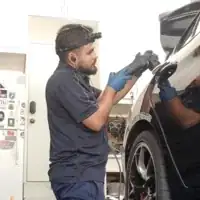 Angel RicardoAngel Ricardo is the owner of Ricardo's Mobile Auto Detail headquartered in Venice, California. With over 10 years of experience in mobile detailing, Angel continues to attend auto detailing trainings to improve his customer service and auto detailing skills.
Angel RicardoAngel Ricardo is the owner of Ricardo's Mobile Auto Detail headquartered in Venice, California. With over 10 years of experience in mobile detailing, Angel continues to attend auto detailing trainings to improve his customer service and auto detailing skills.
Auto Technician You have to protect it every three to six months. Depending on where you live, it can be sooner than that. If you don't, your paint job will start to chip, peel, or rust if you don't. People think that the clear coat can protect the vehicle forever, but you absolutely need to be proactive if you're trying to take care of your car.
You have to protect it every three to six months. Depending on where you live, it can be sooner than that. If you don't, your paint job will start to chip, peel, or rust if you don't. People think that the clear coat can protect the vehicle forever, but you absolutely need to be proactive if you're trying to take care of your car. -
QuestionWhat is clear coat and do you really need it?
 Angel RicardoAngel Ricardo is the owner of Ricardo's Mobile Auto Detail headquartered in Venice, California. With over 10 years of experience in mobile detailing, Angel continues to attend auto detailing trainings to improve his customer service and auto detailing skills.
Angel RicardoAngel Ricardo is the owner of Ricardo's Mobile Auto Detail headquartered in Venice, California. With over 10 years of experience in mobile detailing, Angel continues to attend auto detailing trainings to improve his customer service and auto detailing skills.
Auto Technician
-
QuestionCan I paint my own car?
 Angel RicardoAngel Ricardo is the owner of Ricardo's Mobile Auto Detail headquartered in Venice, California. With over 10 years of experience in mobile detailing, Angel continues to attend auto detailing trainings to improve his customer service and auto detailing skills.
Angel RicardoAngel Ricardo is the owner of Ricardo's Mobile Auto Detail headquartered in Venice, California. With over 10 years of experience in mobile detailing, Angel continues to attend auto detailing trainings to improve his customer service and auto detailing skills.
Auto Technician
Warnings
- Paint fumes can be harmful and potentially lethal. Safety precautions include using an appropriate vapor respirator, such as an organic respirator, and ensuring the workspace is well ventilated.[18]⧼thumbs_response⧽
Things You'll Need
- Safety gear: respirator, nitrile gloves, eye protection, coveralls with hood
- Air compressor
- Paint sprayer (HVLP, LVLP, or airless)
- Dual-action (DA) power sander with sanding pads
- Hand sandpaper (120, 600, 1200, 1500, 2000 grits)
- Metal grinder (for rust spots)
- Body filler and putty knife (for patches)
- Solvents for cleaning surfaces
- Masking tape and paper
- Primer
- Paint (enamel, acrylic enamel, or polyurethane)
- Clear coat lacquer
- Paint thinner and catalyst or hardener
References
- ↑ https://www.osha.gov/dts/maritime/sltc/ships/surfaceprep/spray_painting.html
- ↑ https://www.autobodytoolmart.com/how-to-paint-a-car-t.aspx
- ↑ Angel Ricardo. Auto Technician. Expert Interview. 1 October 2019.
- ↑ https://garage.eastwood.com/eastwood-chatter/paint_your_car/
- ↑ Angel Ricardo. Auto Technician. Expert Interview. 1 October 2019.
- ↑ https://www.eastwood.com/how-to-paint-your-car-on-a-budget-eastwood-tech-library
- ↑ https://www.popularmechanics.com/cars/how-to/a3110/a-diy-guide-to-painting-your-car-15998013/
- ↑ https://www.popularmechanics.com/cars/how-to/a3110/a-diy-guide-to-painting-your-car-15998013/
- ↑ https://www.autobodytoolmart.com/how-to-paint-a-car-t.aspx
- ↑ https://www.popularmechanics.com/cars/how-to/a3110/a-diy-guide-to-painting-your-car-15998013/
- ↑ https://www.popularmechanics.com/cars/how-to/a3110/a-diy-guide-to-painting-your-car-15998013/
- ↑ https://www.carsdirect.com/car-maintenance/how-to-apply-car-paint-primer-correctly
- ↑ https://www.popularmechanics.com/cars/how-to/a3110/a-diy-guide-to-painting-your-car-15998013/
- ↑ https://www.popularmechanics.com/cars/how-to/a3110/a-diy-guide-to-painting-your-car-15998013/
- ↑ https://www.popularmechanics.com/cars/how-to/a3110/a-diy-guide-to-painting-your-car-15998013/
- ↑ https://garage.eastwood.com/eastwood-chatter/paint_your_car/
- ↑ https://www.carsdirect.com/car-maintenance/how-to-apply-car-paint-primer-correctly
- ↑ http://www.autotraining.edu/blog/5-auto-body-painting-safety-tips/
About This Article
To paint a car, start by removing any rust and repairing any dents that are present. Then, remove any chrome or plastic trim that you can and use masking tape to protect everything you don't want to paint. Sand down the body until you can see primer or the metal underneath and clean the body of the car. After it is clean, apply a corrosion resistant, self-etching primer. Once the primer has cured, sand the car down with a 600 grit wet/dry paper and then apply wax and your finishing paint. To learn how to get a final polish on your paint job, read on!
